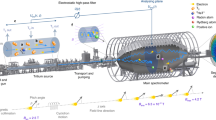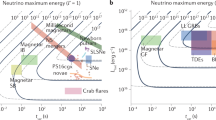Abstract
THE view has recently been put forward1 that a neutral particle of about electronic mass, and spin ½h (where h = h/2) exists, and that this neutrino is emitted together with an electron in decay. This assumption allows the conservation laws for energy and angular momentum to hold in nuclear physics2, Both the emitted electron and neutrino could be described either (a) as having existed before in the nucleus or (b) as being created at the time of emission. In a recent paper3 Fermi has proposed a model of disintegration using (b) which seems to be confirmed by experiment.
Similar content being viewed by others
Article PDF
References
W. Pauli, quoted repeatedly since 1931, to be published shortly in "Rapports du Septième Conseil Solvay, Brussels", 1933.
C. D. Ellis and N. F. Mott, Proc. Roy. Soc., A, 141, 502; 1933.
E. Fermi, La Ricefca Scientifica, 2, No. 12; 1933.
This point of view was first put forward by I. Curie and F. Joliot, at the Conseil Solvay, 1933.
I. Curie and F. Joliot, NATURE, 133, 201, Feb. 10, 1934.
Author information
Authors and Affiliations
Rights and permissions
About this article
Cite this article
BETHE, H., PEIERLS, R. The “Neutrino”. Nature 133, 532 (1934). https://doi.org/10.1038/133532a0
Issue Date:
DOI: https://doi.org/10.1038/133532a0
This article is cited by
-
A terminological history of early elementary particle physics
Archive for History of Exact Sciences (2023)
-
Existence problems in philosophy and science
Synthese (2013)
Comments
By submitting a comment you agree to abide by our Terms and Community Guidelines. If you find something abusive or that does not comply with our terms or guidelines please flag it as inappropriate.



